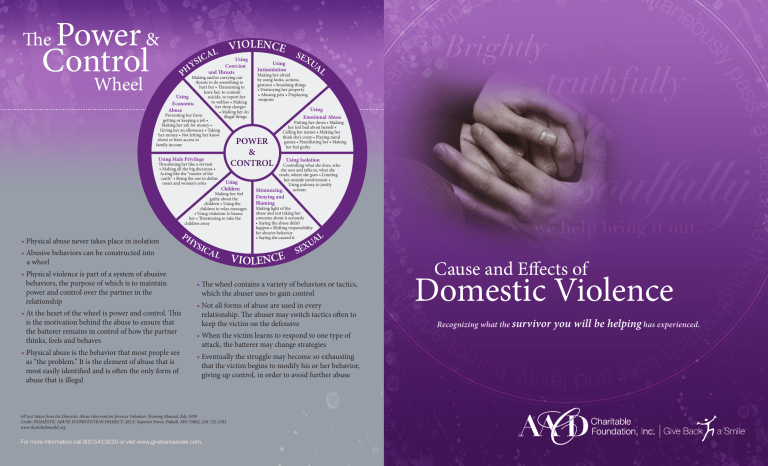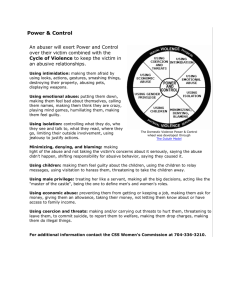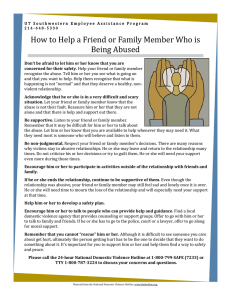
Power & Control The Wheel VIOLENCE AL Using IC S Coercion Y H and Threats P Making and/or carrying out threats to do something to hurt her • Threatening to leave her, to commit Using suicide, to report her to welfare • Making Economic her drop charges Abuse • Making her do Preventing her from illegal things getting or keeping a job • Making her ask for money • Giving her an allowance • Taking her money • Not letting her know about or have access to family income Using Children Making her feel guilty about the children • Using the children to relay messages • Using visitation to harass her • Threatening to take the children away • Physical abuse never takes place in isolation • Abusive behaviors can be constructed into a wheel •P hysical violence is part of a system of abusive behaviors, the purpose of which is to maintain power and control over the partner in the relationship • At the heart of the wheel is power and control. This is the motivation behind the abuse to ensure that the batterer remains in control of how the partner thinks, feels and behaves • Physical abuse is the behavior that most people see as “the problem.” It is the element of abuse that is most easily identified and is often the only form of abuse that is illegal PH YS ICA L SEX UA L Making her afraid by using looks, actions, gestures • Smashing things • Destroying her property • Abusing pets • Displaying weapons Using Emotional Abuse POWER & CONTROL Using Male Privilege Threatening her like a servant • Making all the big decisions • Acting like the “master of the castle” • Being the one to define men’s and women’s roles Using Intimidation Putting her down • Making her feel bad about herself • Calling her names • Making her think she’s crazy • Playing mind games • Humiliating her • Making her feel guilty Using Isolation Controlling what she does, who she sees and talks to, what she reads, where she goes • Limiting her outside involvement • Using jealousy to justify actions Minimizing, Denying and Blaming Making light of the abuse and not taking her concerns about it seriously • Saying the abuse didn’t happen • Shifting responsibility for abusive behavior • Saying she caused it VIOLENCE AL U SEX • Th e wheel contains a variety of behaviors or tactics, which the abuser uses to gain control •N ot all forms of abuse are used in every relationship. The abuser may switch tactics often to keep the victim on the defensive •W hen the victim learns to respond to one type of attack, the batterer may change strategies •E ventually the struggle may become so exhausting that the victim begins to modify his or her behavior, giving up control, in order to avoid further abuse All text taken from the Domestic Abuse Intervention Services Volunteer Training Manual, July 1999 Credit: DOMESTIC ABUSE INTERVENTION PROJECT: 202 E. Superior Street, Duluth, MN 55802, 218-722-2781 www.theduluthmodel.org For more information call 800.543.9220 or visit www.givebackasmile.com. Cause and Effects of Domestic Violence Recognizing what the survivor you will be helping has experienced. Cause and Effects of Domestic Violence The following information will help you to recognize what the survivor you will be helping has experienced. It may provide insight to his or her world, shedding light on behaviors, past and present. Please review carefully. Cycle of Violence Remember: Violence Occurs Honeymoon Phase Hitting, damaging property, yelling, making threats, pushing, punching, etc. Often marked by apologies, excuses, remorse, doing things to try and “make up” for one’s actions, saying “it won’t happen again,” buying presents, etc. • Abuse is not random, it occurs within a system of behaviors designed to exert control • Violence is not constant; there are three distinct phases in the cycle • The three phases vary in time and frequency Potential Long-Term Emotional and Behavioral Effects of Domestic Violence Old feelings and thoughts return, fighting increases, being critical or disrespectful towards one’s partner, being judgmental, personal anger increases. • Flashbacks and nightmares may occur long after the abuse has ended • Depression and suicidal tendencies • Loss of hope for the future • Low self-esteem • Violence increases in severity and frequency, if the cycle is not broken Rising Tension Image copied from: http://www.saskatoonhealthregion.ca/your_health/images/cycle_of_violence.jpg • Inability to trust others • Anxiety • Inability to concentrate Source: http://divorcesupport.about.com/od/abusiverelationships/p/effects_abuse.htm Victims Stay Because… • Th ey still harbor some hope and/or do not know what else to do • The abuser has promised to change • The abuser feels hurt and makes the victim feel guilty for leaving. They are supposed to stand behind their partner • Th ey have no money, no one to help them, no way to earn a living, and no place to go • Th e abuser has threatened to kill them if they leave, and they have every reason to believe the abuser will carry out this threat • In the past, attempts to leave the relationship have resulted in more severe violence • The alternative may be loneliness and poverty Abuser Victim Tension Building Tension Building • Minor battering incidents occur including verbal and psychological abuse • Becomes nurturing, compliant, will stay out of the abuser’s way •A buser may be aware of own inappropriate behavior, but doesn’t take responsibility • Denies escalation of abuse and inevitability of serious incident • Afraid that their partner will leave, jealousy and possessiveness increases with the hope that brutality will keep victim captive • Accepts the abuse. Believes that what they do can prevent the abuser’s anger from escalating. They attempt to alter behavior as a way of providing safety • Frantic, more control. Abuser misinterprets partner’s behavior, takes withdrawal as rejection • Rationalizes abuse (everybody has marriage problems, etc.) • Outside events can affect this stage • Blames external factors, such as stress or alcohol • Abuser feels uncontrollable •T ension becomes unbearable. Stress-related illness is common. Victim may feel anxious, depressed, sleepless, fatigued, may over/under eat, or experience tension headaches • Their strong religious beliefs may cause them to feel guilty to leave the marriage, or break up the family • Of the children All text taken from the Domestic Abuse Intervention Services Volunteer Training Manual, July 1999



